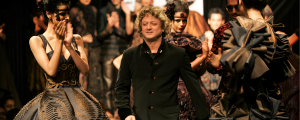Rohit Bal wasn’t just a fashion designer; he was a master storyteller. His runway shows, often set in historic locations and with artistic choreography, were theatrical experiences. Bal’s signature style merged India’s rich textile heritage with modern globally-relevant design, celebrating craftsmanship and grandeur, and earned the title of “India’s Master of Fabric and Fantasy” from Time Magazine.
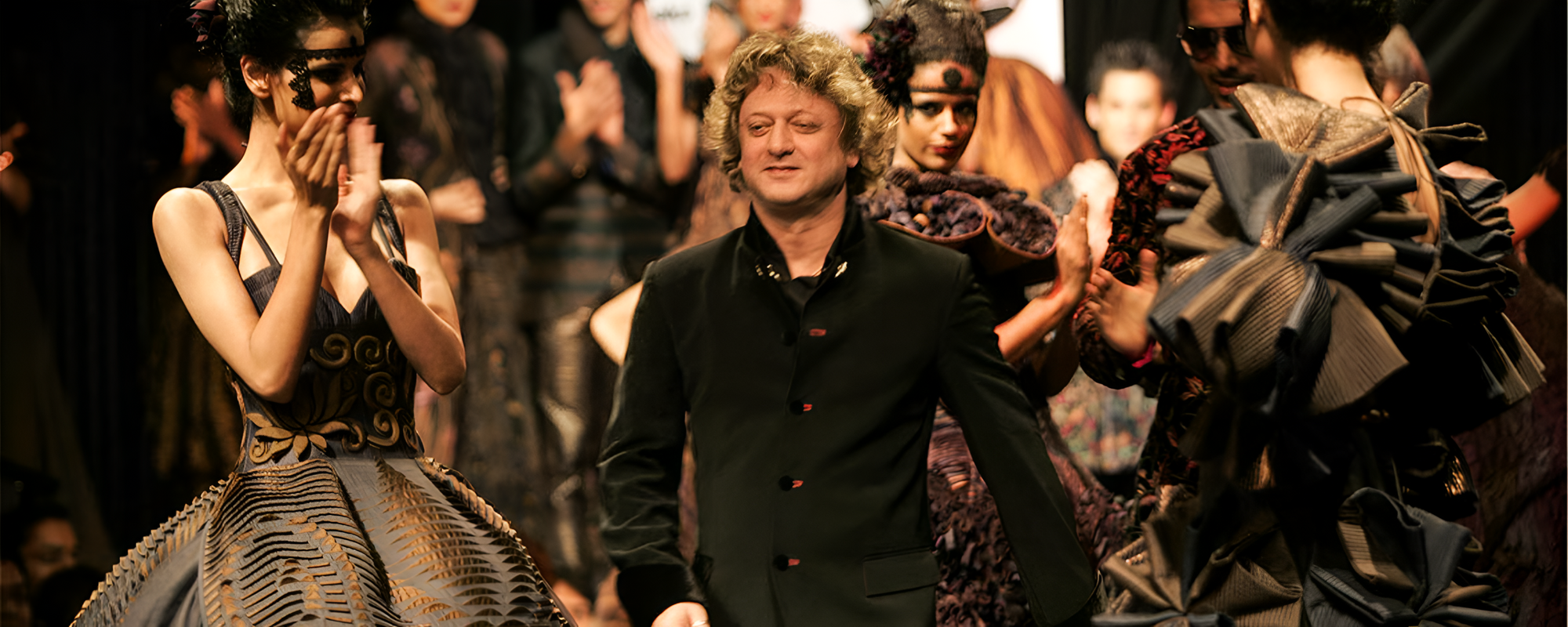
Rohit Bal
Hailing from Kashmir and settled in New Delhi, India, Rohit Bal was born on May 8, 1961 in Srinagar and later shifted to New Delhi. Graduating from St. Stephen’s New Delhi with a degree in history, he diversified into fashion design at the National Institute of Fashion Technology and initially worked in his family’s export business, learning the industry’s fundamentals before launching his own label in 1989. The fashion brand went down in Indian fashion history for its rich hand embroidery, masterful craftsmanship and sophisticated, minimalist silhouettes. His silhouettes were grand — fluid lehengas, long floor-duster coats, regal sherwanis and bandhgalas, all embellished with huge motifs of the lotus, Nandi the bull, peacocks and roses.
Bal drew inspiration from his Kashmiri heritage and, for him, cut and finish were as crucial as intricate hand embroidery and embellishment. “I always stuck to who I am and never did what everybody else was doing. I have a very strong and focused design philosophy, and I adhere to that. I believe anything you do from your heart and soul will always stay relevant. I am comfortable in being classic, elegant, and timeless, and it has contributed a lot to my brand and career as a designer,” he said during an interview wit the Press Trust of India.
Today, the fashion brand continues post his death with haute couture, ready to wear, fashion accessories, fragrance and a denim line. The fashion industry kept his legacy alive with a posthumous showing where Indian supermodels, Bollywood celebrities, friends, fashion fraternity, and family were present. Let’s take a closer look at Indian fashion legend Rohit Bal.
Rohit Bal: Legacy Shows
Rohit Bal’s most iconic showing was preceded with a dramatic presentation by a dance troupe whose leader dressed as Lord Krishna. This theatrical presentation served as a prologue to the runway show, integrating it with a sense of Indian tradition, fantasy, and folklore. The show itself was acclaimed for its unique integration of artistry and design aesthetic, characteristic of Bal’s work. The electrifying experience tapped into a sense of feeling the land, of imbibing tradition… and charged the show as supermodels walked the runway in his collection.
In another season, his guests were awestruck by the haunting beauty of the creative presentation—it’s not every day the a luxury hotel The Lodhi witnesses supermodels taking a bow with the fashion designer, inside a swimming pool filled with lotuses under the moonlight. The experience was inclusive of the craftsmanship, the element of fantasy, the energy of youth. And, who can forget male models on his catwalk with sindoor in their maang as a tribute to the alpha man? Or a fashion show set against the backdrop of the Qutub Minar with the melodic voice of Shubha Mudgal?
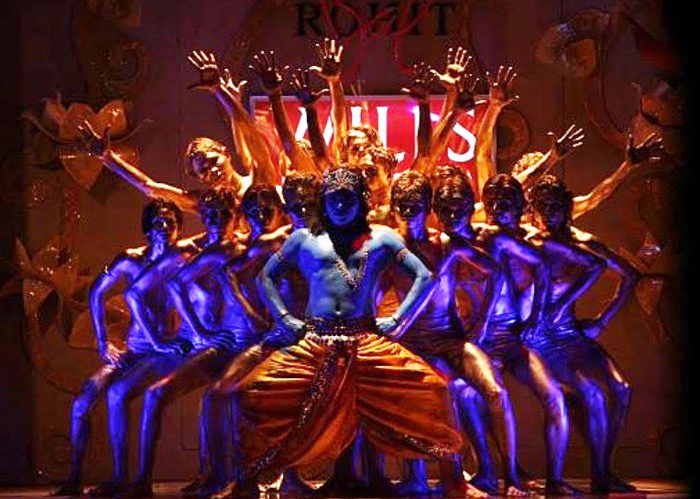
Rohit Bal’s most iconic show was preceded with a dramatic presentation by a dance troupe whose leader dressed as Lord Krishna.

It’s not every day the a luxury hotel witnesses supermodels taking a bow with the fashion designer Rohit Bal- inside a swimming pool!
Why Rohit Bal Is Culturally Relevant
Although he makes his mastery of the craft appear effortless, integral to Rohit Bal’s design aesthetic is the juxtaposition between traditional textile craft, Kashmir hand embroideries and a modern design sensibility, in collaboration with rural weavers. Time magazine hailed him as “India’s master of fabric and fantasy” in 1996, and several fashion editors referred to him as “India’s John Galliano.”
Taking inspiration from history and folklore art, Rohit Bal uses Lotus and Peacock motifs in a lot of his designs. The two omnipresent motifs have become his signature style, and are intricately featured. Per Vogue: “Consider him a name so apt for some who understood the measure of how to be maximalist, yet has restraint and refinement. Both meticulous and measured, his emphasis on craftsmanship and early acknowledgement of the karigars’s role in Indian fashion set him apart. Beyond his undisputed talent lies the person himself– Rohit Bal, the maverick with a love for living the good life.”
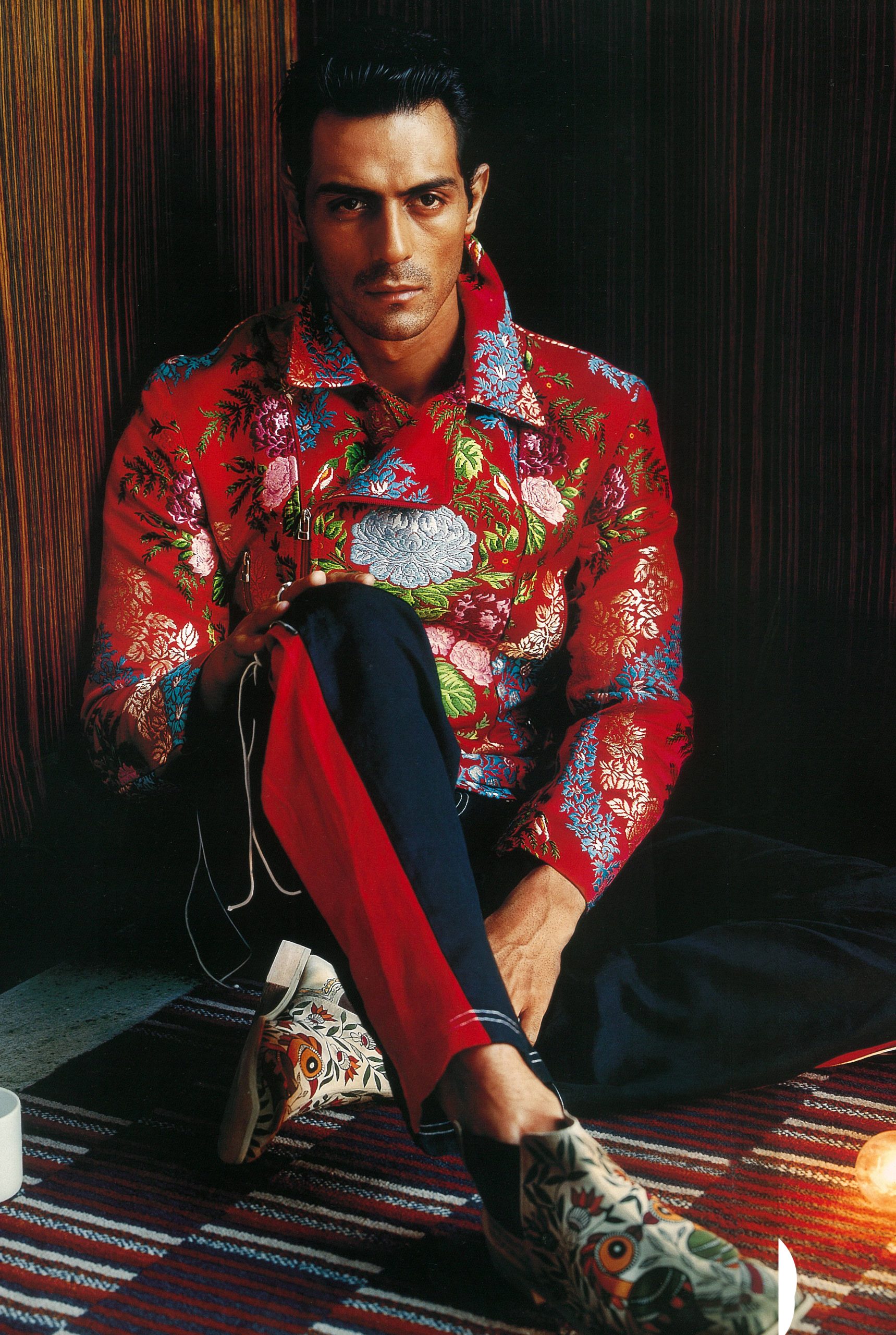
Arjun Rampal in Rohit Bal
Few know that Rogit Bal’s atelier nurtured iconic Indian designers Manish Arora, Pankaj and Nidhi, and Sahil Kocchar. He is also popular for collaborating with sewing machine brand Usha Silai to design a collection stitched by craftswomen from Kashmir; all profits from the sales of this collection were given to the underprivileged craftswomen. Each of them got mentored by Rohit Bal and the opportunity to understand craft techniques, silhouettes and fit, their life-transforming takeaway was financial empowerment. Per Hindu, he said, “The emotional strength of this collection is where its uniqueness lies. The fact that Kashmiri women artisans are living in the middle of a war zone, yet they’ve made such exquisite pieces within a stipulated period, that too in freezing weather, speaks for their skills and hard work.”
He is not just a creative powerhouse. Bal’s business acumen is evident in the diversification and collaborations, to strengthen his brand equity. The designer launched restaurant chain Veda and fine dining Cibo. He further diversified into Rohit Bal Luxury Weddings and forged alliances with brands including Omega, Aditya Birla Group, Chivas Regal, Mitsubishi, Hidesign, Reid and Taylor, Christian Louboutin and Lancôme, and was an ambassador for Omega. “These collaborations are not limited to me being a public face of the brand. It involves utilising my ideas to create a certain look for the product” he says.
Rohit Bal has held fashion shows in London, Paris, New York, Singapore, Moscow, Jakarta, Colombo, Sao Paulo, Munich, Geneva and India… and was always brimming with creative ideas. So it doesn’t come as a surprise that his clientele includes the global A-list set, Uma Thurman, Cindy Crawford and Naomi Campbell. Sadly, however, Rohit Bal died after a long battle with a pre-existing cardiac condition. In true theatrical style, he recovered for a short time, showcased his final collection in front of the entire fashion fraternity, and then passed away.
10 lesser known facts about Rohit Bal
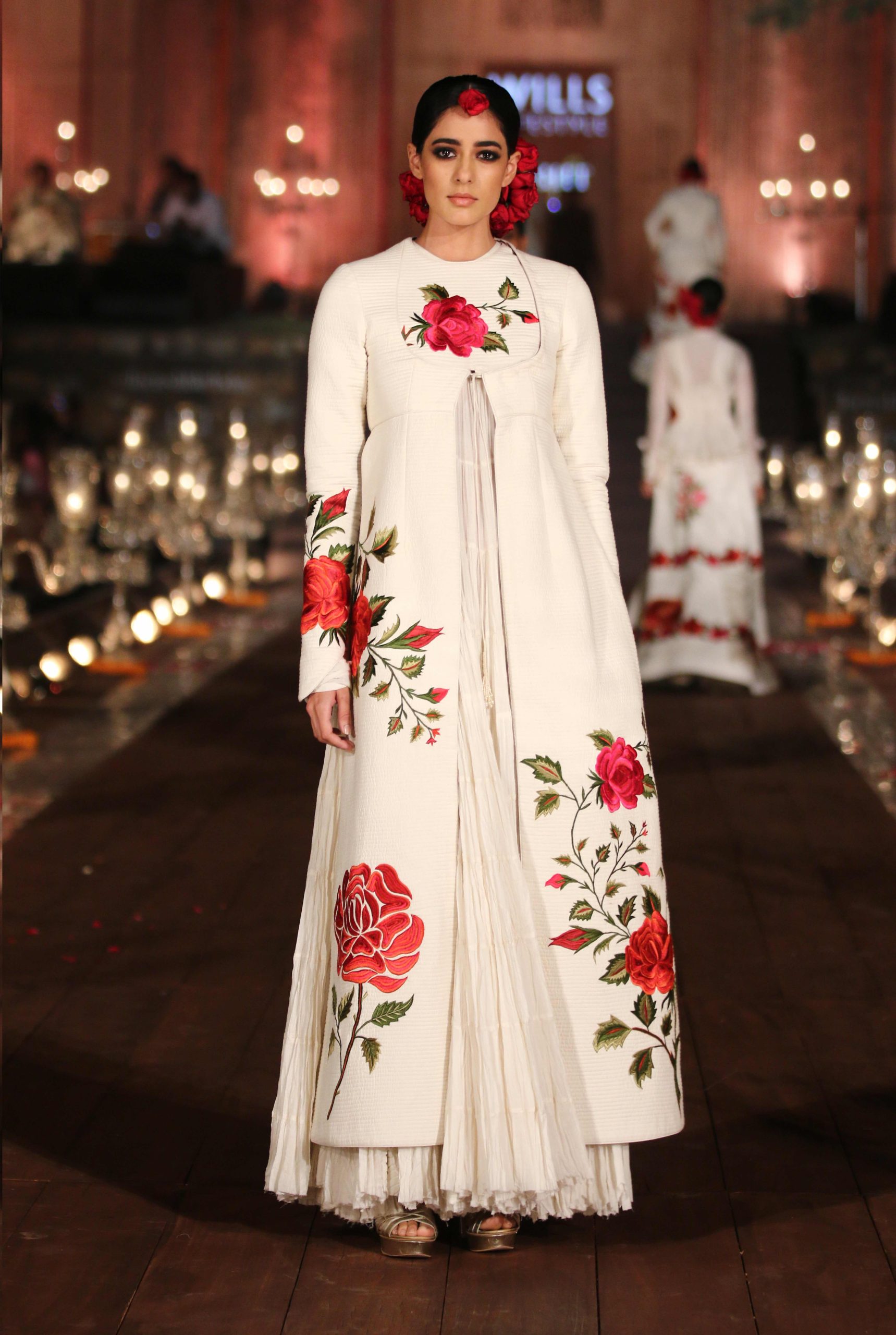
Gulbagh by Rohit Bal
Kashmiri Origins
He was born in Srinagar, Kashmir, in 1961. His roots in Kashmir deeply influenced his aesthetic (rich fabrics, regal hand embroidery) though his career took off in New Delhi.Studied History Before Fashion
Bal earned a Bachelor’s degree in History from St Stephen’s College, New Delhi.Master of Fabric and Fantasy
The magazine Time dubbed him ‘Master of fabric and fantasy’ because of his lavish textiles, dramatic silhouettes and rich motifs. His shows weren’t presentations: they were immersive.Signature Motifs: Lotus & Peacock
He frequently used lotus flowers, peacocks, vines in his designs. These motifs signalled heritage, nature and an Indian identity reimagined.Started in Menswear in 1990
After initial work in an export business, he launched his own independent collection in 1990 focused on traditional menswear. He later expanded into womenswear and accessories.Global Celebrity Clientele
His clients included the likes of Cindy Crawford, Uma Thurman and Naomi Campbell.Runway as Spectacle
He treated his runway as theatre.Health Battles Late in Career
He suffered a massive heart attack in 2010 and subsequent health issues. Despite these, he made notable comebacks — showing his resilience and passion for design.Educator of Indian Textiles
Bal had a strong respect for Indian hand‑loom textiles such as khadi, banarasi brocade and sought to preserve craft. His work helped bring artisanal textiles into high fashion.His Legacy Lives On
He passed away in November 2024. But his influence remains strong and his style is referenced in bridal couture and fashion education.
Jasmeen Dugal is Associate Editor at FashionABC, contributing her insights on fashion, technology, and sustainability. She brings with herself more than two decades of editorial experience, working for national newspapers and luxury magazines in India.
Jasmeen Dugal has worked with exchange4media as a senior writer contributing articles on the country’s advertising and marketing movements, and then with Condenast India as Net Editor where she helmed Vogue India’s official website in terms of design, layout and daily content. Besides this, she is also an entrepreneur running her own luxury portal, Explosivefashion, which highlights the latest in luxury fashion and hospitality.






